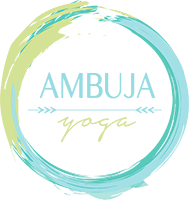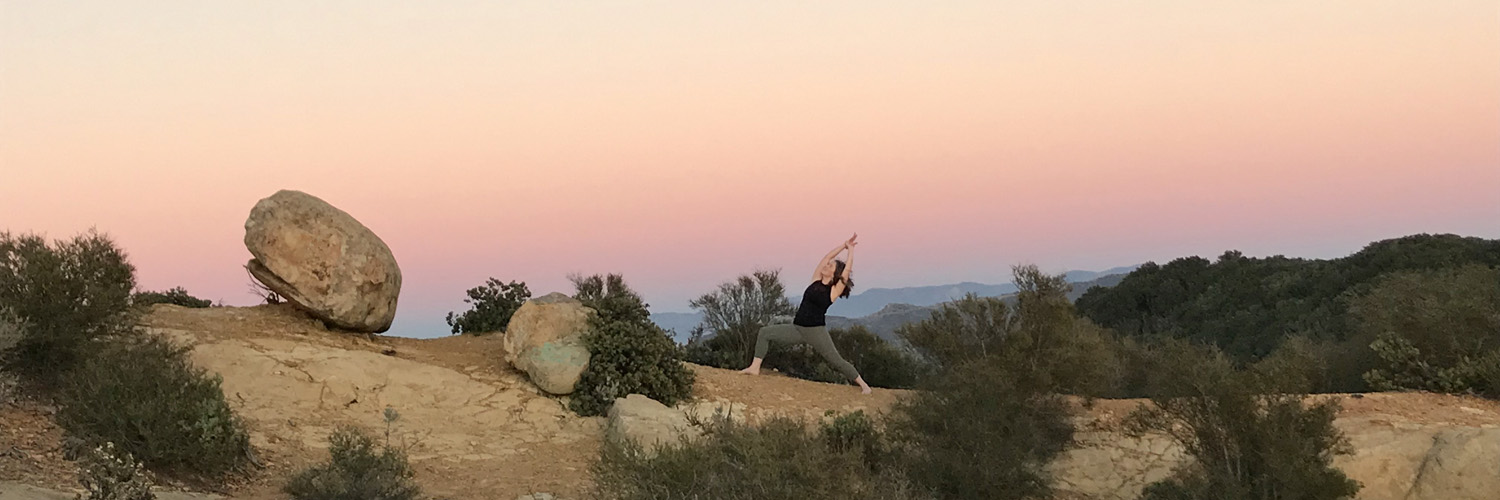Welcome beautiful human! I’m excited to share this yoga nidra inspired by the ocean with you. This yoga nidra, or yogic sleep, is inspired by my short time living by the sea in Santa Barbara, California. I used to love taking the pups over to the beach for a romp in the surf and when the tide was just right I would find all kinds of little gems — sea glass, perfect little shells, and polished stones. We often saw dolphins and seals (or sea lions?) playing in the surf. I often wondered if they were just as enchanted by us as we were by them. It was a beautiful place to call home.
If yoga nidra is new to you, check out some of my other yoga nidra resources:

We’ll practice yoga nidra in shavasana. If you’re not comfortable in shavasana, find a comfortable seat or lie on your side. For shavasana, slide a bolster or folded blanket underneath your knees and another blanket or pillow underneath the back of your head. The body temperature tends to drop during yoga nidra, so a blanket over the top of your body is usually really nice too. Let’s drop into this ocean-inspired yoga nidra.
Preliminary Relaxation For This Yoga Nidra Inspired by the Ocean
Take the next couple of minutes to get really comfortable. Adjust your props, your clothing and remove any distractions from your space. Once we’re in the practice of yoga nidra, you will want to remain still for the duration.
Settle in. Take care of any last-minute wiggles and invite in a sense of stillness and calm. Close down your eyes and bring your awareness to your breath. Without changing your breath, simply witness it. Witness the rise and fall of your breath at your belly. Witnessing this sacred, natural rhythm. Unhurried. Unrestricted. Stay with the rise and fall of your breath.
Witness its ebb and flow. Your inhale releases into your exhale and your exhale surrenders into your inhale. PAUSE
Yoga Nidra Sankalpa
In yoga nidra we work with a sankalpa. A sankalpa is a positive “I am” statement that is true at the core of who you are. It is your essence simplified into a short positive “I am” statement. Bring into your mind’s eye your sankalpa. Once it has formed, repeat it quietly and internally to yourself three times. PAUSE
Remain aware of my voice and be still throughout the remainder of practice. The practice of yoga nidra begins now.
Rotation of Consciousness
Remain aware of my voice and do not sleep. I will guide you through a rotation of consciousness all you have to do is follow along and move your awareness from point to point within your body.
- Move your awareness to your mouth
- Become aware of your tongue
- Lower jaw
- Lower row of teeth
- Upper row of teeth
- Gums
- Upper lip
- Lower lip
- Space between your lips
- Both cheeks
- Right ear
- Left ear
- Forehead
- Both temples
- Top of the head
- Back of the head
- Tip of the nose
- Right nostril
- Left nostril
- Right eyelid
- Left eyelid
- Right eye
- Left eye
- Right eyebrow
- Left eyebrow
- Space between the eyebrows
- Now go to the right hand
- The right hand thumb
- Second finger
- Third finger
- Fourth finger
- Little finger
- Palm of the hand
- Back of the hand
- wrist
- forearm
- elbow
- Upper arm
- shoulder
- Right armpit
- ribs
- waist
- hip
- Right thigh
- knee
- calf
- ankle
- Heel
- Sole of the foot
- Top of the foot
- Right big toe
- Second toe
- Third toe
- Fourth toe
- Little toe
- Now Go to the left hand
- The left hand thumb
- Second finger
- Third finger
- Fourth finger
- Little finger
- Palm of the hand
- Back of the hand
- wrist
- forearm
- elbow
- Upper arm
- shoulder
- Left armpit
- ribs
- waist
- hip
- Left thigh
- knee
- calf
- ankle
- heel
- Sole of the foot
- Top of the foot
- Left big toe
- second toe
- Third toe
- Fourth toe
- Little toe
- Groin
- Right buttock
- Left buttock
- Lower back
- Mid-back
- Upper back
- Right shoulder blade
- Left shoulder blade
- Back of the neck
- Back of the head
- Right inner ear
- Left inner ear
- Roof of the mouth
- Throat
- Right collar bone
- Left collar bone
- Right chest
- Left chest
- Middle chest
- Upper abdomen
- Navel
- Lower abdomen
- Groin
- Whole spine
- The whole head
- Right arm
- Left arm
- Both arms together
- The whole right leg
- The whole left leg
- Both legs together
- Whole front body
- Whole back body
- Be aware of the whole body. PAUSE
Breath as Prana
Now bring your awareness to your breath. Experience your breath as it is. Follow its natural tide without altering it. Experience the pranic tide of your breath as if your whole body is breathing. Vibrant, white light flowing in and out with each cycle of breath. Waves of sparkling light washing over you with each inhale and falling away with each exhale. Each inhale peaking like a wave of prana cresting and then giving way to the exhale. Experience the peaks and valleys of your breath like the waves of an ocean. PAUSE.
Now count each breath. Count down from 54 to 0. Inhale 54. Exhale 53. Inhale 52. Exhale 51. If you lose count simply begin again. PAUSE
Opposites
Now bring your awareness to an experience of pleasure. Welcome the feeling of pleasure into your being. Hold your awareness on the experience of pleasure.
Now bring your awareness to an experience of pain. Meet the feeling of pain with equanimity. Experience it fully. Hold your awareness on the experience of pain.
Now bring your awareness to your body. Feel your body, mind and soul contracting. Becoming smaller and smaller.
All at once, the body expands. The mind expands. And the soul expands. Body, mind, and soul expanding into the infinite, boundless.
Now bring your awareness to the experience of holding tightly. Experience the gripping in your body and mind.
Now bring your awareness to the experience of letting go. Experience the release in your body and mind.
Archetypal Images
I will now describe images to you. Experience them without attachment and allow them to wash over you.
Your bare feet on the earth
You see a meandering path
Tall tufts of grass line the trail
Follow the path toward the sound of the ocean
You glimpse the ocean’s glimmering waves
The sea is calm
Your path gently gives way to a wide stretch of golden sand
You see the vast expanse of sea stretches out before you
The sun dances off the crest of each wave
Your breath in sync with the rhythmic pulse of the ocean
Miles of shimmery sand in each direction
Seabirds dart and dive
Puffs of clouds drift overhead
Dolphins play just beyond the waves
You walk over to the edge of the water
With each step little crabs scurry away
You stop and roll up your jeans
The water flows over your toes
Tiny shells, little gems, and sparkly stones turned and tossed by the gentle sea
A perfect shell washes up to your feet
You reach down and pick it up admiring its perfection
You peacefully slide it into your pocket and walk along the beach toward distant cliffs
A large piece of driftwood provides a spot to sit and rest
You turn your gaze toward the horizon and you take in your surroundings
A sense of ease washes over you
You reach into your pocket and pull out the shell
You turn it over in your hands, one, two, three times
You see a tiny inscription — it’s your sankalpa
Now, repeat your sankalpa internally to yourself. Speak it into the deepest layers of your being with meaning and intention. PAUSE
Gently bring your awareness back to your physical body lying on the earth. Experience your breath as the waves of an ocean. Sensation coming back. Arms. Legs. Torso. Head. Without opening your eyes, find a bit of movement. Little movements to start and finally a full body stretch. The practice of yoga nidra is complete. When you’re ready, roll over onto your side and pause there for a breath or two before coming up to a seat.
I hope you enjoyed this yoga nidra inspired by the ocean and beaches of sunny California. If you would like to learn more about yoga nidra, join me for a yoga teacher training or retreat. Both are great ways to learn more about this immensely healing practice.
Many blessings to you.
Love,
Autumn
Permissions for live in-person classes only: This script is copyrighted Ambuja Yoga© 2020, all rights reserved. You may use this script to guide live in-person classes or events only. Descriptions and advertising for any live in-person class using this script in whole or in part must include one of the following attributions: script ©Ambuja Yoga used by permission, or modified from script ©Ambuja Yoga used by permission.
This use does not convey the right to borrow from this script or to reproduce it in any way. No part of this script may be reproduced, distributed, stored in a retrieval system, or transmitted in any form or by any means, including photocopying, digital copying, print, audio or video recording, or other electronic or mechanical methods, without the prior written permission of the copyright owner.
Other Resources for Yoga Nidra
- Book: Yoga Nidra by Swami Satyananda Saraswati
- Book: Yoga Nidra: A Meditative Practice for Deep Relaxation and Healing by Richard Miller
- Book: Yoga Nidra: The Art of Transformational Sleep by Kamini Desai (this one is really good on Audible)

 Ambuja Yoga
Ambuja Yoga 









